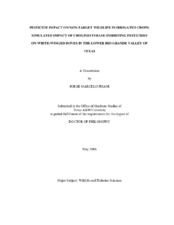| dc.description.abstract | I present a simulation model that should be a useful tool for risk assessment of the impact of insecticide inhibitors of cholinesterase (ChE) applied in irrigated agricultural fields on non-target wildlife. I developed the model as a compartment model based on difference equations (Δt = 1 hour) and programmed with Stella® VII software. Conceptually the model is compartmentalized into six submodels describing the dynamics of (1) insecticide application, (2) insecticide movement into floodable soil, (3) irrigation and rain, (4) insecticide dissolution in water, (5) foraging and insecticide intake from water, and (6) ChE inhibition and recovery. To demonstrate application of the model, I simulate historical, current, and “worst-case†scenarios, that examined the impact of ChE-inhibiting insecticides on white-winged doves (WWDO - Zenaida asiatica) in the Lower Rio Grande Valley of Texas (LRGV), USA. To my knowledge, there are no field data verifying that the cause of ChE deprivation in WWDO is due to the ingestion of ChE-inhibiting insecticide residues dissolved in drinking water. I parameterized the model to represent a system composed of fields of cotton, sorghum, corn, citrus, and brushland that encompasses the activity range of a WWDO in the LRGV. I simulated situations representing the typical scenario of WWDO using irrigated crop fields in the absence and in the presence of rain. I also simulated “worst case†scenarios in which methyl parathion was applied at high rates and high frequency. Based on results of the simulations, I conclude that it is unlikely that WWDO are seriously exposed to ChE-inhibiting insecticides by drinking contaminated water. Only in rare cases, for example, when a rain event occurs just after the application of insecticides, are levels of ChE inhibition likely to approach diagnostic levels (20 %). The present simulation model should be a useful tool to predict the effect of ChE-inhibiting insecticides on the ChE activity of different species that drink contaminated water from irrigated agricultural fields. It should be particularly useful in identifying specific situations in which the juxtaposition of environmental conditions and management schemes could result in a high risk to non-target wildlife. | en |


